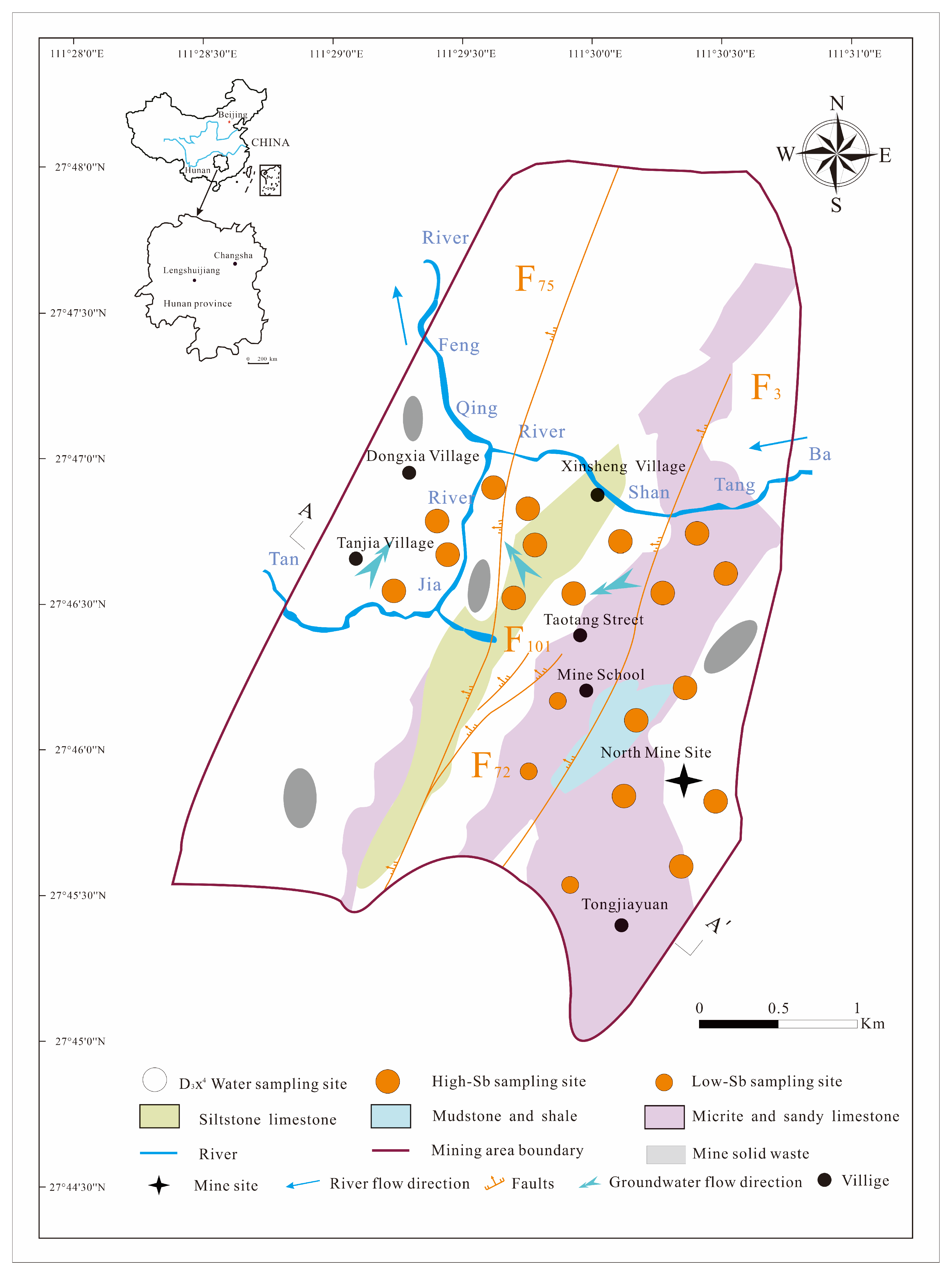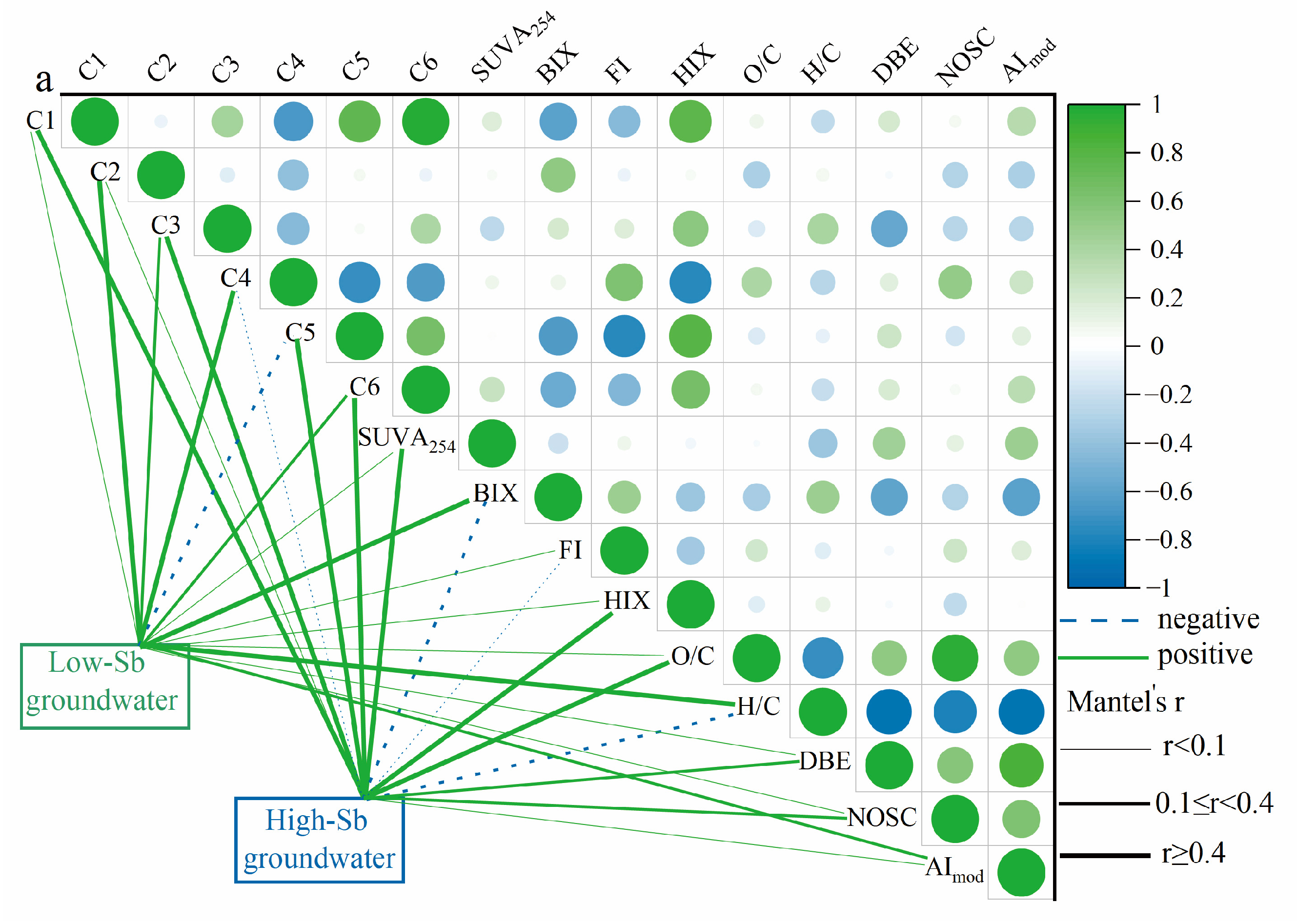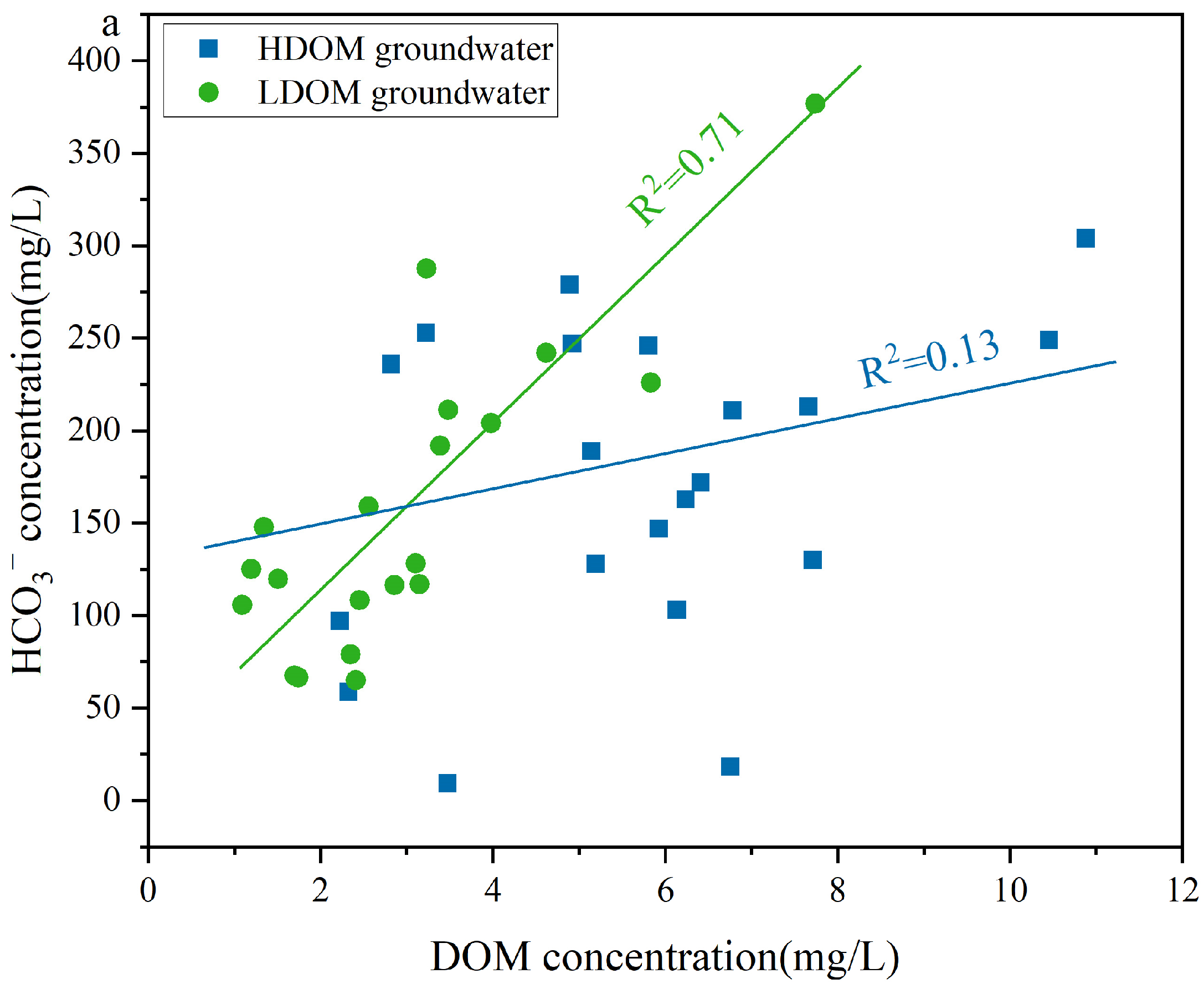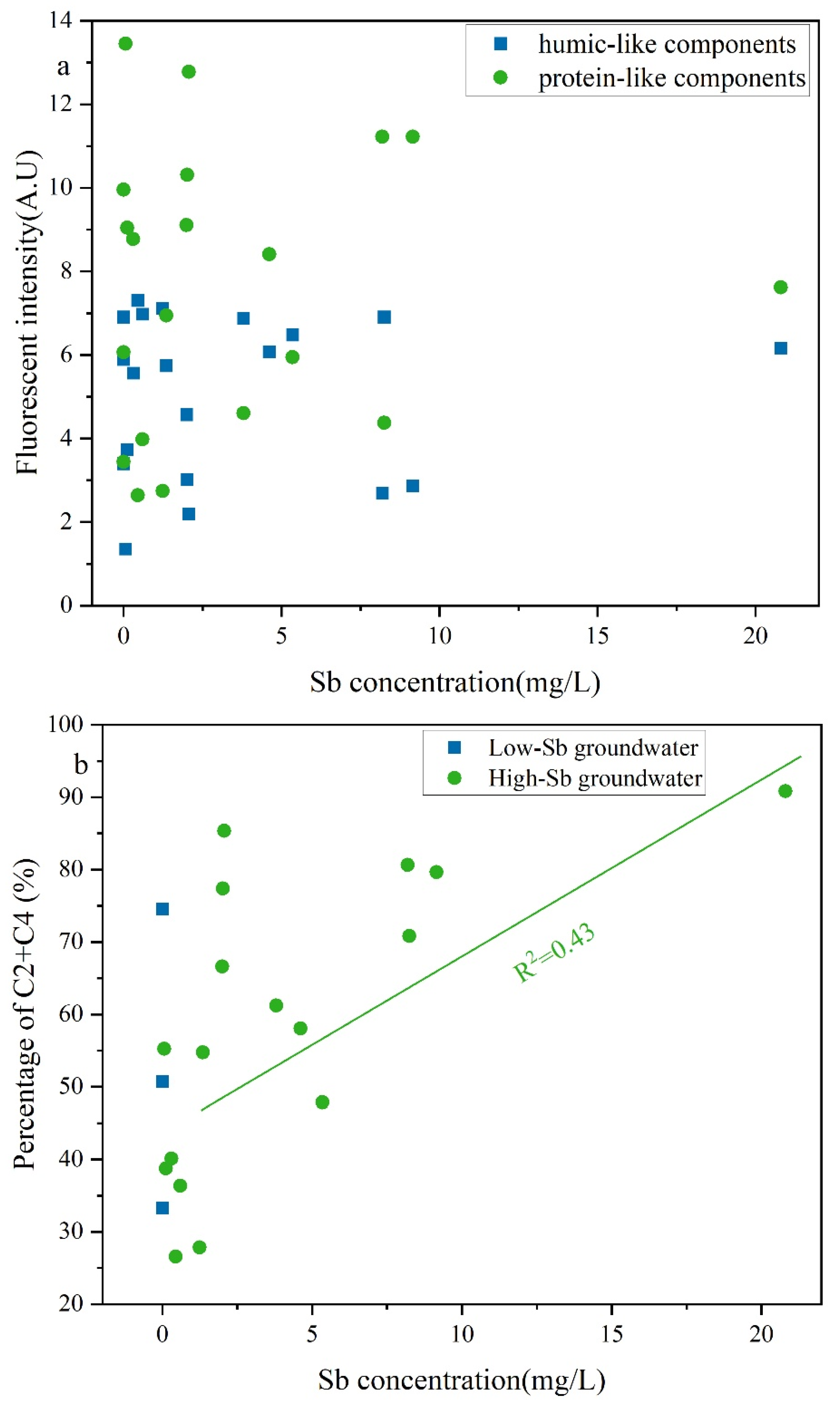Unravelling the Effect of Low-Molecular-Weight Dissolved Organic Matter on Antimony Enrichment in Groundwater of the Xikuangshan Sb Mining Area, China
Abstract
:1. Introduction
2. Materials and Methods
2.1. Study Area
2.2. Groundwater Sampling and Analyses
2.3. EEM-PARAFAC and FT-ICR MS Analysis
3. Results
3.1. Geochemical Characterization of HDOM and LDOM Groundwater
3.2. Fluorescent Characteristics of DOM in HDOM and LDOM Groundwater
3.3. Molecular Characteristics of DOM in HDOM and LDOM Groundwater
4. Discussion
4.1. Competitive Adsorption Effect
4.2. Microorganisms Sb(III) Oxidative Dissolution
5. Conclusions
Supplementary Materials
Author Contributions
Funding
Data Availability Statement
Conflicts of Interest
References
- Qi, P.; Pichler, T. Sequential and simultaneous adsorption of Sb (III) and Sb (V) on ferrihydrite: Implications for oxidation and competition. Chemosphere 2016, 145, 55–60. [Google Scholar] [CrossRef]
- Leuz, A.K.; Johnson, C.A.R. Oxidation of Sb (III) to Sb (V) by O2 and H2O2 in aqueous solutions. Geochim. Cosmochim. Acta 2005, 69, 1165–1172. [Google Scholar] [CrossRef]
- Shan, J.; He, M.; Lin, C.; Ouyang, W.; Liu, X. Simultaneous electrochemical determination of Sb (III) and Sb (V) in Water samples: Deposition potential differences and Sb (III) photooxidation characteristics. Sens. Actuators B-Chem. 2020, 305, 127454. [Google Scholar] [CrossRef]
- Hao, C.; Zhang, W.; Gui, H. Hydrogeochemistry characteristic contrasts between low-and high-antimony in shallow drinkable groundwater at the largest antimony mine in hunan province, China. Appl. Geochem. 2020, 117, 1693545. [Google Scholar] [CrossRef]
- Hao, C.; Liu, M.; Peng, Y.; Wei, Z. Comparison of Antimony Sources and Hydrogeochemical Processes in Shallow and Deep Groundwater Near the Xikuangshan Mine, Hunan Province, China. Mine Water Environ. 2022, 41, 194–209. [Google Scholar] [CrossRef]
- GB 5749-2022; Standards for Drinking Water Quality. State Administration for Market Regulation and Standardization Administration of China: Beijing, China, 2022.
- Filella, M.; Belzile, N.; Chen, Y.-W. Antimony in the environment: A review focused on natural waters: II. Relevant solution chemistry. Earth-Sci. Rev. 2002, 59, 265–285. [Google Scholar] [CrossRef]
- Wu, Z.; He, M.; Guo, X.; Zhou, R. Removal of antimony (III) and antimony (V) from drinking water by ferric chloride coagulation: Competing ion effect and the mechanism analysis. Sep. Purif. Technol. 2010, 76, 184–190. [Google Scholar] [CrossRef]
- Hao, C.; Gui, H.; Sheng, L.; Miao, J.; Lian, H. Contrasting water-rock interaction behaviors of antimony and arsenic in contaminated rivers around an antimony mine, Hunan Province, China. Geochemistry 2021, 81, 125748. [Google Scholar] [CrossRef]
- Wang, A.; He, M.; Ouyang, W.; Lin, C.; Liu, X. Effects of antimony (III/V) on microbial activities and bacterial community structure in soil. Sci. Total Environ. 2021, 789, 148073. [Google Scholar] [CrossRef]
- Jia, X.; Majzlan, J.; Ma, L.; Liu, P.; Fan, P.; Li, W.; Zhou, J.; Wen, B. Novel insights into the mechanisms for Sb mobilization in groundwater in a mining area: A colloid field study. J. Hazard. Mater. 2023, 459, 132212. [Google Scholar] [CrossRef]
- Kong, T.; Sun, X.; Gu, Z.; Yang, N.; Huang, Y.; Lan, L.; Gao, P.; Liu, H.; Wang, Y.; Jiang, F.; et al. Differential Mechanisms of Microbial As (III) and Sb (III) Oxidation and Their Contribution to Tailings Reclamation. Environ. Sci. Technol. 2024, 58, 11447–11458. [Google Scholar] [CrossRef]
- Guo, X.; Wu, Z.; He, M.; Meng, X.; Jin, X.; Qiu, N.; Zhang, J. Adsorption of antimony onto iron oxyhydroxides: Adsorption behavior and surface structure. J. Hazard. Mater. 2014, 276, 339–345. [Google Scholar] [CrossRef]
- Kong, L.; Hu, X.; He, M. Mechanisms of Sb (III) Oxidation by Pyrite-Induced Hydroxyl Radicals and Hydrogen Peroxide. Environ. Sci. Technol. 2015, 49, 3499–3505. [Google Scholar] [CrossRef] [PubMed]
- Li, J.; Bao, H.; Xiong, X.; Sun, Y.; Guan, X. Effective Sb (V) immobilization from water by zero-valent iron with weak magnetic field. Sep. Purif. Technol. 2015, 151, 276–283. [Google Scholar] [CrossRef]
- Li, Q.; Huang, M.; Shu, S.; Chen, X.; Gao, N.; Zhu, Y. Quinone-mediated Sb removal from sulfate-rich wastewater by anaerobic granular sludge: Performance and mechanisms. Sci. Total Environ. 2022, 838, 156217. [Google Scholar] [CrossRef] [PubMed]
- Fan, Y.; Zheng, C.; Huo, A.; Wang, Q.; Shen, Z.; Xue, Z.; He, C. Investigating the binding properties between antimony (V) and dissolved organic matter (DOM) under different pH conditions during the soil sorption process using fluorescence and FTIR spectroscopy. Ecotoxicol. Environ. Saf. 2019, 181, 34–42. [Google Scholar] [CrossRef]
- Dündar, O.A.; Mehenktaş, C.; Arar, Ö. Removal of Antimony (III) and Antimony (V) from water samples through water-soluble polymer-enhanced ultrafiltration. Environ. Res. 2022, 215, 114324. [Google Scholar] [CrossRef]
- Bagherifam, S.; Brown, T.C.; Bagherifam, S.; Baglieri, A. Sequential extraction of labile and recalcitrant fractions of soil organic matter: A case study focusing on antimony (Sb) in humic acids, fulvic acids and humin fractions of long-term aged contaminated soils. Environ. Pollut. 2023, 327, 121610. [Google Scholar] [CrossRef]
- Xi, J.; He, M.; Kong, L. Adsorption of antimony on kaolinite as a function of time, pH, HA and competitive anions. Environ. Earth Sci. 2016, 75, 136. [Google Scholar] [CrossRef]
- Karimian, N.; Johnston, S.G.; Tavakkoli, E.; Frierdich, A.J.; Burton, E.D. Mechanisms of Arsenic and Antimony Co-sorption onto Jarosite: An X-ray Absorption Spectroscopic Study. Environ. Sci. Technol. 2023, 57, 4813–4820. [Google Scholar] [CrossRef]
- Wang, Y.; Kong, L.; He, M.; Lin, C.; Ouyang, W.; Liu, X.; Peng, X. Mechanistic insights into Sb (III) and Fe (II) co-oxidation by oxygen and hydrogen peroxide: Dominant reactive oxygen species and roles of organic ligands. Water Res. 2023, 242, 120296. [Google Scholar] [CrossRef]
- Kong, L.; He, M. Mechanisms of Sb (III) Photooxidation by the Excitation of Organic Fe (III) Complexes. Environ. Sci. Technol. 2016, 50, 6974–6982. [Google Scholar] [CrossRef]
- Wu, T.-l.; Qin, W.-x.; Alves, M.E.; Fang, G.-D.; Sun, Q.; Cui, P.-x.; Liu, C.; Zhou, D.-m.; Wang, Y.-j. Mechanisms of Sb (III) oxidation mediated by low molecular weight phenolic acids. Chem. Eng. J. 2019, 356, 190–198. [Google Scholar] [CrossRef]
- Hao, C.; Sun, Q.; Sun, X.; Li, Q. Novel insights into antimony mobilization in different high- antimony aquifers from the molecular signatures of dissolved organic matter. Ecotoxicol. Environ. Saf. 2024, 277, 116377. [Google Scholar] [CrossRef] [PubMed]
- Li, X.; Guo, H.; Zheng, H.; Xiu, W.; He, W.; Ding, Q. Roles of different molecular weights of dissolved organic matter in arsenic enrichment in groundwater: Evidences from ultrafiltration and EEM-PARAFAC. Appl. Geochem. 2019, 104, 124–134. [Google Scholar] [CrossRef]
- Gao, Z.; Guo, H.; Qiao, W.; He, C.; Shi, Q.; Ke, T.; Cao, Y. Dissolved Organic Matter Sources in High Arsenic Groundwater from a Sand-Gravel Confined Aquifer. J. Geophys. Res.-Biogeosci. 2023, 128, e2022JG007178. [Google Scholar] [CrossRef]
- Wu, T.-l.; Sun, Q.; Fang, G.-d.; Cui, P.-x.; Liu, C.; Alves, M.E.; Qin, W.-x.; Zhou, D.-m.; Shi, Z.-q.; Wang, Y.-j. Unraveling the effects of gallic acid on Sb (III) adsorption and oxidation on goethite. Chem. Eng. J. 2019, 369, 414–421. [Google Scholar] [CrossRef]
- Qiao, W.; Guo, H.; He, C.; Shi, Q.; Zhao, B. Unraveling roles of dissolved organic matter in high arsenic groundwater based on molecular and optical signatures. J. Hazard. Mater. 2021, 406, 124702. [Google Scholar] [CrossRef]
- Wang, Y.; Kong, L.; He, M.; Ouyang, W.; Lin, C.; Liu, X. Influences of Particles and Aquatic Colloids on the Oxidation of Sb (III) in Natural Water. Acs Earth Space Chem. 2020, 4, 661–671. [Google Scholar] [CrossRef]
- Wang, X.; He, M.; Lin, C.; Gao, Y.; Zheng, L. Antimony (III) oxidation and antimony (V) adsorption reactions on synthetic manganite. Chem. Der Erde-Geochem. 2012, 72, 41–47. [Google Scholar] [CrossRef]
- Wen, B.; Zhou, J.; Zhou, A.; Liu, C.; Xie, L. Sources, migration and transformation of antimony contamination in the water environment of Xikuangshan, China: Evidence from geochemical and stable isotope (S, Sr) signatures. Sci. Total Environ. 2016, 569, 114–122. [Google Scholar] [CrossRef] [PubMed]
- Wen, B.; Zhou, A.; Zhou, J.; Liu, C.; Huang, Y.; Li, L. Coupled S and Sr isotope evidences for elevated arsenic concentrations in groundwater from the world’s largest antimony mine, Central China. J. Hydrol. 2018, 557, 211–221. [Google Scholar] [CrossRef]
- Maqbool, T.; Sun, M.; Chen, L.; Zhang, Z. Exploring the fate of dissolved organic matter at the molecular level in the reactive electrochemical ceramic membrane system using fluorescence spectroscopy and FT-ICR MS. Water Res. 2022, 210, 117979. [Google Scholar] [CrossRef] [PubMed]
- Ohno, T.; Parr, T.B.; Gruselle, M.-C.I.; Fernandez, I.J.; Sleighter, R.L.; Hatcher, P.G. Molecular Composition and Biodegradability of Soil Organic Matter: A Case Study Comparing Two New England Forest Types. Environ. Sci. Technol. 2014, 48, 7229–7236. [Google Scholar] [CrossRef]
- Phungsai, P.; Kurisu, F.; Kasuga, I.; Furumai, H. Changes in Dissolved Organic Matter Composition and Disinfection Byproduct Precursors in Advanced Drinking Water Treatment Processes. Environ. Sci. Technol. 2018, 52, 3392–3401. [Google Scholar] [CrossRef] [PubMed]
- Liu, S.; Hou, J.; Suo, C.; Chen, J.; Liu, X.; Fu, R.; Wu, F. Molecular-level composition of dissolved organic matter in distinct trophic states in Chinese lakes: Implications for eutrophic lake management and the global carbon cycle. Water Res. 2022, 217, 118438. [Google Scholar] [CrossRef]
- Maqbool, T.; Sun, M.; Chen, L.; Zhang, Z. Molecular-level characterization of natural organic matter in the reactive electrochemical ceramic membrane system for drinking water treatment using FT-ICR MS. Sci. Total Environ. 2022, 846, 157531. [Google Scholar] [CrossRef]
- Ning, C.; Gao, Y.; Zhang, H.; Wang, L.; Yu, H.; Zou, L.; Cao, R.; Chen, J. Molecular chemodiversity of water-soluble organic matter in atmospheric particulate matter and their associations with atmospheric conditions. Sci. Total Environ. 2022, 809, 151171. [Google Scholar] [CrossRef]
- Zark, M.; Christoffers, J.; Dittmar, T. Molecular properties of deep-sea dissolved organic matter are predictable by the central limit theorem: Evidence from tandem FT-ICR-MS. Mar. Chem. 2017, 191, 9–15. [Google Scholar] [CrossRef]
- Zhang, B.; Shan, C.; Wang, S.; Fang, Z.; Pan, B. Unveiling the transformation of dissolved organic matter during ozonation of municipal secondary effluent based on FT-ICR-MS and spectral analysis. Water Res. 2021, 188, 116484. [Google Scholar] [CrossRef]
- Xu, H.; Li, X.; Guo, M.; Li, F.; Yang, K.; Liu, X. Dissolved organic matters with low molecular weight fractions exhibit high photochemical potential for reactive oxygen formation. Chemosphere 2022, 305, 135542. [Google Scholar] [CrossRef]
- Du, L.; Liu, Y.; Hao, Z.; Chen, M.; Li, L.; Ren, D.; Wang, J. Fertilization regime shifts the molecular diversity and chlorine reactivity of soil dissolved organic matter from tropical croplands. Water Res. 2022, 225, 119106. [Google Scholar] [CrossRef] [PubMed]
- Guo, X.-J.; He, X.-S.; Li, C.-W.; Li, N.-X. The binding properties of copper and lead onto compost-derived DOM using Fourier-transform infrared, UV-vis and fluorescence spectra combined with two-dimensional correlation analysis. J. Hazard. Mater. 2019, 365, 457–466. [Google Scholar] [CrossRef] [PubMed]
- Kulkarni, H.; Mladenov, N.; Datta, S. Effects of acidification on the optical properties of dissolved organic matter from high and low arsenic groundwater and surface water. Sci. Total Environ. 2019, 653, 1326–1332. [Google Scholar] [CrossRef] [PubMed]
- Richards, L.A.; Lapworth, D.J.; Magnone, D.; Gooddy, D.C.; Chambers, L.; Williams, P.J.; van Dongen, B.E.; Polya, D.A. Dissolved organic matter tracers reveal contrasting characteristics across high arsenic aquifers in Cambodia: A fluorescence spectroscopy study. Geosci. Front. 2019, 10, 1653–1667. [Google Scholar] [CrossRef]
- Sun, Y.; Lan, J.; Chen, X.; Ye, H.; Du, D.; Li, J.; Hou, H. High arsenic levels in sediments, Jianghan Plain, central China: Vertical distribution and characteristics of arsenic species, dissolved organic matter, and microbial community. J. Geochem. Explor. 2021, 228, 106822. [Google Scholar] [CrossRef]
- Aftabtalab, A.; Rinklebe, J.; Shaheen, S.M.; Niazi, N.K.; Moreno-Jiménez, E.; Schaller, J.; Knorr, K.-H. Review on the interactions of arsenic, iron (oxy)(hydr)oxides, and dissolved organic matter in soils, sediments, and groundwater in a ternary system. Chemosphere 2022, 286, 131790. [Google Scholar] [CrossRef]
- Malik, A.; Parvaiz, A.; Mushtaq, N.; Hussain, I.; Javed, T.; Rehman, H.U.; Farooqi, A. Characterization and role of derived dissolved organic matter on arsenic mobilization in alluvial aquifers of Punjab, Pakistan. Chemosphere 2020, 251, 126374. [Google Scholar] [CrossRef]
- Wang, Y.; Zhang, G.; Wang, H.; Cheng, Y.; Liu, H.; Jiang, Z.; Li, P.; Wang, Y. Effects of different dissolved organic matter on microbial communities and arsenic mobilization in aquifers. J. Hazard. Mater. 2021, 411, 125146. [Google Scholar] [CrossRef]
- Pi, K.; Wang, Y.; Xie, X.; Huang, S.; Yu, Q.; Yu, M. Geochemical effects of dissolved organic matter biodegradation on arsenic transport in groundwater systems. J. Geochem. Explor. 2015, 149, 8–21. [Google Scholar] [CrossRef]
- Guo, H.; Li, X.; Xiu, W.; He, W.; Cao, Y.; Zhang, D.; Wang, A. Controls of organic matter bioreactivity on arsenic mobility in shallow aquifers of the Hetao Basin, PR China. J. Hydrol. 2019, 571, 448–459. [Google Scholar] [CrossRef]
- Gao, S.-X.; Zhang, X.; Fan, W.-Y.; Sheng, G.-P. Molecular insight into the variation of dissolved organic phosphorus in a wastewater treatment plant. Water Res. 2021, 203, 117529. [Google Scholar] [CrossRef]
- Ge, J.; Qi, Y.; Li, C.; Ma, J.; Yi, Y.; Hu, Q.; Mostofa, K.M.G.; Volmer, D.A.; Li, S.-L. Fluorescence and molecular signatures of dissolved organic matter to monitor and assess its multiple sources from a polluted river in the farming-pastoral ecotone of northern China. Sci. Total Environ. 2022, 837, 154575. [Google Scholar] [CrossRef] [PubMed]
- Huang, Z.; Lv, J.; Cao, D.; Zhang, S. Iron plays an important role in molecular fractionation of dissolved organic matter at soil-water interface. Sci. Total Environ. 2019, 670, 300–307. [Google Scholar] [CrossRef] [PubMed]
- Yang, P.; Jiang, T.; Cao, D.; Sun, T.; Liu, G.; Guo, Y.; Liu, Y.; Yin, Y.; Cai, Y.; Jiang, G. Unraveling Multiple Pathways of Electron Donation from Phenolic Moieties in Natural Organic Matter. Environ. Sci. Technol. 2023, 57, 16895–16905. [Google Scholar] [CrossRef]
- Li, Z.; Shakiba, S.; Deng, N.; Chen, J.; Louie, S.M.; Hu, Y. Natural Organic Matter (NOM) Imparts Molecular-Weight-Dependent Steric Stabilization or Electrostatic Destabilization to Ferrihydrite Nanoparticles. Environ. Sci. Technol. 2020, 54, 6761–6770. [Google Scholar] [CrossRef]
- Saalfield, S.L.; Bostick, B.C. Synergistic effect of calcium and bicarbonate in enhancing arsenate release from ferrihydrite. Geochim. Cosmochim. Acta 2010, 74, 5171–5186. [Google Scholar] [CrossRef]
- Huang, S.; Chen, M.; Diao, Y.; Feng, Q.; Zeng, R.J.; Zhou, S. Dissolved Organic Matter Acting as a Microbial Photosensitizer Drives Photoelectrotrophic Denitrification. Environ. Sci. Technol. 2022, 56, 4632–4641. [Google Scholar] [CrossRef]
- Kulkarni, H.V.; Mladenov, N.; Johannesson, K.H.; Datta, S. Contrasting dissolved organic matter quality in groundwater in Holocene and Pleistocene aquifers and implications for influencing arsenic mobility. Appl. Geochem. 2017, 77, 194–205. [Google Scholar] [CrossRef]
- Qiu, J.; Li, T.; Lu, F.; Huang, Y.; Li, C.; Zhang, H.; Shao, L.; He, P. Molecular behavior and interactions with microbes during anaerobic degradation of bio-derived DOM in waste leachate. J. Environ. Sci. 2023, 126, 174–183. [Google Scholar] [CrossRef]
- Xi, J.; He, M.; Lin, C. Adsorption of antimony (III) and antimony (V) on bentonite: Kinetics, thermodynamics and anion competition. Microchem. J. 2011, 97, 85–91. [Google Scholar] [CrossRef]
- Xi, J.; He, M.; Wang, K.; Zhang, G. Adsorption of antimony(III) on goethite in the presence of competitive anions. J. Geochem. Explor. 2013, 132, 201–208. [Google Scholar] [CrossRef]
- Xi, J.; He, M.; Lin, C. Adsorption of antimony (V) on kaolinite as a function of pH, ionic strength and humic acid. Environ. Earth Sci. 2010, 60, 715–722. [Google Scholar] [CrossRef]
- Saada, A.; Breeze, D.; Crouzet, C.; Cornu, S.; Baranger, P. Adsorption of arsenic (V) on kaolinite and on kaolinite-humic acid complexes-Role of humic acid nitrogen groups. Chemosphere 2003, 51, 757–763. [Google Scholar] [CrossRef] [PubMed]
- Groeneveld, M.; Catalan, N.; Attermeyer, K.; Hawkes, J.; Einarsdottir, K.; Kothawala, D.; Bergquist, J.; Tranvik, L. Selective Adsorption of Terrestrial Dissolved Organic Matter to Inorganic Surfaces Along a Boreal Inland Water Continuum. J. Geophys. Res. Biogeosci. 2020, 125, e2019JG005236. [Google Scholar] [CrossRef]
- Liu, Z.; Song, L.; Yan, W.; Chen, M.; Zhong, Z.; Li, C. Mechanisms of antimony release from lacustrine sediments with increasing temperature*. Environ. Pollut. 2023, 323, 121301. [Google Scholar] [CrossRef]
- Li, J.; Liu, M.; Tong, L.; Zhou, Y.; Kong, L. Decomposition of waterside plants greatly affects the transformation and mobility of sedimentary antimony in water-sediment-sediment systems after emergency treatment: A microcosm study. J. Hazard. Mater. 2024, 478, 135598. [Google Scholar] [CrossRef]
- Qiu, X.; Chen, M.; Wu, P.; Li, Y.; Sun, L.; Shang, Z.; Wang, T.; Dang, Z.; Zhu, N. Influence of dissolved organic matter with different molecular weight from chicken manure on ferrihydrite adsorption and re-release of antimony (V). J. Environ. Manag. 2024, 358, 120883. [Google Scholar] [CrossRef]
- Zhang, E.; Wu, S.; Liu, J.; Li, H.; Liu, X.; Lu, Y.; Ge, C.; Zhou, D. Activated carbon as a strong DOM adsorbent mitigates antimony and arsenic release in flooded mining-impacted soils. J. Hazard. Mater. 2024, 473, 134663. [Google Scholar] [CrossRef]
- Chen, B.; Zhao, M.; Liu, C.; Feng, M.; Ma, S.; Liu, R.; Chen, K. Comparison of copper binding properties of DOM derived from fresh and pyrolyzed biomaterials: Insights from multi-spectroscopic investigation. Sci. Total Environ. 2020, 721, 137827. [Google Scholar] [CrossRef]
- Guo, X.; Xie, X.; Liu, Y.; Wang, C.; Yang, M.; Huang, Y. Effects of digestate DOM on chemical behavior of soil heavy metals in an abandoned copper mining areas. J. Hazard. Mater. 2020, 393, 122436. [Google Scholar] [CrossRef] [PubMed]
- Wu, Y.; Xi, B.; Fang, F.; Kou, B.; Gang, C.; Tang, J.; Tan, W.; Yuan, Y.; Yu, T. Insights into relationships between polycyclic aromatic hydrocarbon concentration, bacterial communities and organic matter composition in coal gangue site. Environ. Res. 2023, 236, 116502. [Google Scholar] [CrossRef] [PubMed]
- Yang, H.; Lu, X.; He, M. Effect of organic matter on mobilization of antimony from nanocrystalline titanium dioxide. Environ. Technol. 2018, 39, 1515–1521. [Google Scholar] [CrossRef] [PubMed]
- Hao, C.; Sun, X.; Peng, Y.; Xie, B.; He, K.; Wang, Y.; Liu, M.; Fan, X. Geochemical impact of dissolved organic matter on antimony mobilization in shallow groundwater of the Xikuangshan antimony mine, Hunan Province, China. Sci. Total Environ. 2023, 860, 160292. [Google Scholar] [CrossRef]
- Li, Y.; Gong, X.; Sun, Y.; Shu, Y.; Niu, D.; Ye, H. High molecular weight fractions of dissolved organic matter (DOM) determined the adsorption and electron transfer capacity of DOM on iron minerals. Chem. Geol. 2022, 604, 120907. [Google Scholar] [CrossRef]
- Abdelrady, A.; Sharma, S.; Sefelnasr, A.; Kennedy, M. Characterisation of the impact of dissolved organic matter on iron, manganese, and arsenic mobilisation during bank filtration. J. Environ. Manag. 2020, 258, 110003. [Google Scholar] [CrossRef]
- Wang, K.-L.; Min, D.; Chen, G.-L.; Liu, D.-F.; Yu, H.-Q. Oxidation of Sb (III) by Shewanella species with the assistance of extracellular organic matter. Environ. Res. 2023, 236, 116834. [Google Scholar] [CrossRef]
- Yu, X.; Feng, Y.; Yang, A.; Hu, X.; Li, Q.; Song, X.; He, Y. Humic Substances-Induced Changes in the Properties of Sb-Contaminated Soil and Effects on Sb Forms. Water Air Soil Pollut. 2024, 235, 144. [Google Scholar] [CrossRef]
- Su, L.; Wang, S.; Ji, R.; Zhuo, G.; Liu, C.; Chen, M.; Li, H.; Zhang, L. New insight into the role of FDOM in heavy metal leaching behavior from MSWI bottom ash during accelerated weathering using fluorescence EEM-PARAFAC. Waste Manag. 2022, 144, 153–162. [Google Scholar] [CrossRef]
- Nguyen, V.K.; Choi, W.; Yu, J.; Lee, T. Microbial oxidation of antimonite and arsenite by bacteria isolated from antimony-contaminated soils. Int. J. Hydrogen Energy 2017, 42, 27832–27842. [Google Scholar] [CrossRef]
- Loni, P.C.; Wu, M.; Wang, W.; Wang, H.; Ma, L.; Liu, C.; Song, Y.; Tuovinen, O.H. Mechanism of microbial dissolution and oxidation of antimony in stibnite under ambient conditions. J. Hazard. Mater. 2020, 385, 121561. [Google Scholar] [CrossRef] [PubMed]












| Type | C1 | C2 | C3 | C4 | C5 | C6 |
|---|---|---|---|---|---|---|
| % | ||||||
| HDOM groundwater (n = 20) | ||||||
| Max | 30.74 | 45.46 | 27.35 | 42.57 | 21.65 | 35.90 |
| Min | 3.72 | 12.89 | 2.22 | 0.92 | 1.04 | 0.51 |
| Mean | 22.34 | 22.85 | 17.36 | 20.46 | 10.84 | 6.14 |
| SD | 7.35 | 8.21 | 5.48 | 13.42 | 5.53 | 7.14 |
| LDOM groundwater (n = 20) | ||||||
| Max | 30.40 | 47.19 | 22.10 | 68.82 | 15.07 | 7.41 |
| Min | 2.30 | 15.65 | 5.15 | 3.87 | 1.53 | 0.16 |
| Mean | 16.86 | 29.55 | 13.71 | 28.28 | 7.71 | 3.87 |
| SD | 8.74 | 9.31 | 5.17 | 17.27 | 4.41 | 2.24 |
| Categories | H/C Ratio | O/C Ratio |
|---|---|---|
| lipids | 1.50–2.20 | 0–0.30 |
| protein/Aliphatic compounds | 1.50–2.20 | 0.30–0.67 |
| unsaturated hydrocarbons | 0.70–1.50 | 0–0.10 |
| carbohydrates | 1.50–2.50 | 0.67–1.20 |
| lignin-like substances | 0.70–1.50 | 0.10–0.67 |
| tannins-like materials | 0.50–1.50 | 0.67–1.20 |
| condensed aromatics | 0.20–0.70 | 0–0.67 |
Disclaimer/Publisher’s Note: The statements, opinions and data contained in all publications are solely those of the individual author(s) and contributor(s) and not of MDPI and/or the editor(s). MDPI and/or the editor(s) disclaim responsibility for any injury to people or property resulting from any ideas, methods, instructions or products referred to in the content. |
© 2025 by the authors. Licensee MDPI, Basel, Switzerland. This article is an open access article distributed under the terms and conditions of the Creative Commons Attribution (CC BY) license (https://creativecommons.org/licenses/by/4.0/).
Share and Cite
Qin, T.; Li, Z.; Sun, Q.; Hao, C. Unravelling the Effect of Low-Molecular-Weight Dissolved Organic Matter on Antimony Enrichment in Groundwater of the Xikuangshan Sb Mining Area, China. Water 2025, 17, 1206. https://doi.org/10.3390/w17081206
Qin T, Li Z, Sun Q, Hao C. Unravelling the Effect of Low-Molecular-Weight Dissolved Organic Matter on Antimony Enrichment in Groundwater of the Xikuangshan Sb Mining Area, China. Water. 2025; 17(8):1206. https://doi.org/10.3390/w17081206
Chicago/Turabian StyleQin, Tongchun, Zijian Li, Qianqian Sun, and Chunming Hao. 2025. "Unravelling the Effect of Low-Molecular-Weight Dissolved Organic Matter on Antimony Enrichment in Groundwater of the Xikuangshan Sb Mining Area, China" Water 17, no. 8: 1206. https://doi.org/10.3390/w17081206
APA StyleQin, T., Li, Z., Sun, Q., & Hao, C. (2025). Unravelling the Effect of Low-Molecular-Weight Dissolved Organic Matter on Antimony Enrichment in Groundwater of the Xikuangshan Sb Mining Area, China. Water, 17(8), 1206. https://doi.org/10.3390/w17081206






